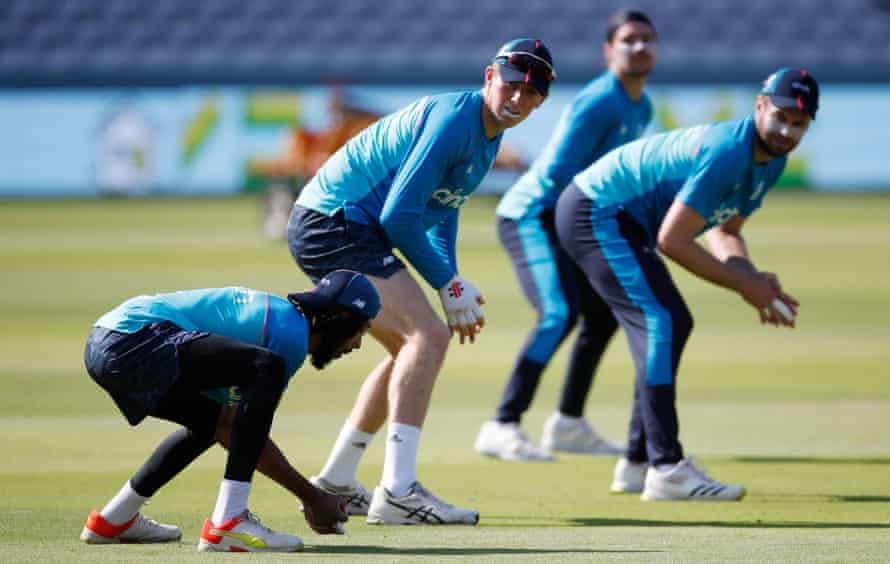[ad_1]
You have to go back to the visit of West Indies to Old Trafford in 2007 – the summer when India last won a Test series on these shores – for the previous time England went into a “live” home Test without either Jimmy Anderson or Stuart Broad at their disposal.
The pair were rested at Edgbaston in 2012, West Indies again the opposition, but that match was a dead rubber. The second Test that begins on Thursday at Lord’s, where the sun is set to shine and the series with India is locked at 0-0 after the soggy end at Trent Bridge, sees England staring into a future they have long been agonising over.
In the case of Broad, who was in line to win his 150th cap, a torn right calf is to blame for his absence for the foreseeable future. For Anderson, a tight left quad leaves him rated “50-50”. The 39-year-old last went into a Test with a niggle at the start of the 2019 Ashes and four overs in his series was over. England were left with a sense of “what if” after failing to win back the urn and with this five-match series so condensed, a similar gamble on his fitness feels unlikely.
If both miss out then opportunity knocks for the support cast and the 23-year-old Sam Curran would be England’s most experienced seamer with 22 caps. This represents a fair old drop from losing the combined 312 matches and 1,145 wickets of experience banked by Anderson and Broad over the course of their stellar careers.
The returning Mark Wood is next on 20 caps and Ollie Robinson – the banker in terms of form – makes just his third appearance and returns to the scene of that soured debut back in June. Moeen Ali’s return at No 7, the spin-bowler in a five-man attack, appears to leave a choice between Saqib Mahmood, a late addition and uncapped in the longest format, or Craig Overton handed his fifth appearance.
Mahmood offers slingy pace and swing, Overton similar bounce and nip to Robinson. If there is to be a tiebreaker, it may well be that the latter’s adhesive hands at slip, and the potential to extend the batting all the way down to 10, sees him shade this. That said, Wood, the likely No 11 in this scenario, would doubtless argue it goes all the way down given he has a Test half-century to his name.
India will be delighted with all this, even if newcomers bring a sense of the unknown, and though the tourists have lost Shardul Thakur to a tight hamstring, they had been planning to draft in Ravichandran Ashwin anyway.

Uncertainty also remains over England’s top three. Haseeb Hameed is creeping closer to a first Test cap since that zesty debut tour of India 2016. Zak Crawley’s average of 11 this year is troubling them hugely, even if his future is considered bright, but they are starting to wonder if Dom Sibley is just too limited.
Moeen’s expected return in place of Dan Lawrence reflects well on a cricketer who could easily have told England where to go after two years of indifference on their part. Chris Silverwood, the head coach, is delighted with the energy Moeen has brought into the dressing room, although a lack of first-class cricket means expectations should be tempered.
But then this summer has been a scheduling car crash overall and beyond the English batsmen caught cold last week – and the absence of any red-ball cricket until 30 August should a player like Crawley drop down – there has been some chuntering about this having led to Anderson and Broad’s issues.
England were already without Ben Stokes, taking time off to prioritise his mental health, Jofra Archer, out for the rest of the year with an elbow stress fracture, and Chris Woakes, whose annus horribilis was summed by slipping on some stairs and bruising his heel. Poor old Olly Stone says it will still be another six months before he bowls again after his lower back stress fracture in June.
But the dearth of first-class cricket in the lead-up to this series always risked the available seamers going physically soft and the GPS tracking data that logs workloads is said to have seen both veterans in the red zone – the point where injury might occur – after Trent Bridge. Anderson bowled just 22 overs for Lancashire in July, Broad 19 for Nottinghamshire, and that was before five Tests in six weeks.
England have overcome such issues in the past with either a warmup match of their own or loan deals to counties who are in action. But this summer the Hundred has been prioritised and England players required for the launch. Anderson and Broad were not part of the new tournament but their options were still limited.
The Spin: sign up and get our weekly cricket email.
Seamers can build up hardiness in the nets but nothing compares to competitive multi-day cricket, where second, third and fourth spells are required in a day. It is why Woakes currently faces an uphill battle to get back to full fitness, with even Warwickshire’s second XI team not playing red-ball cricket until 23 August.
It all feeds into a sense that if England are to prevail against India over the next four Tests, it will be in spite of the system rather than because of it. Joe Root, a captain looking to secure his legacy over the next six months, deserves better.
[ad_2]
Source link